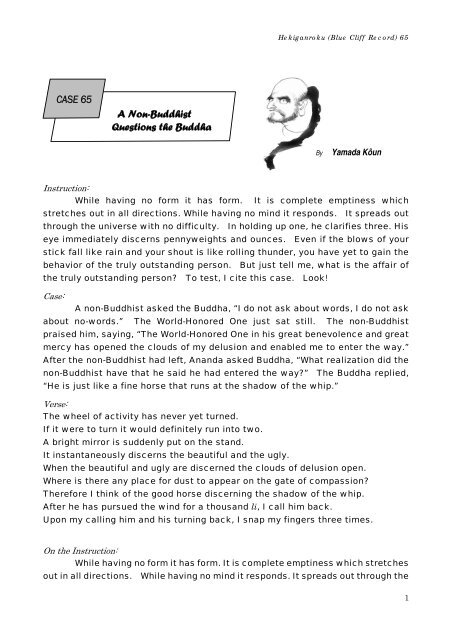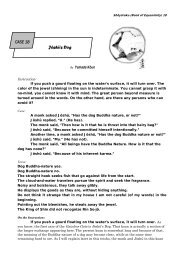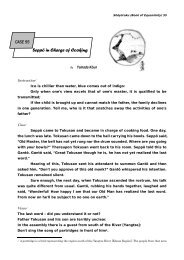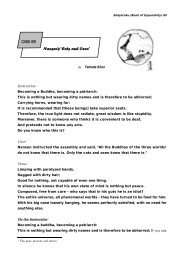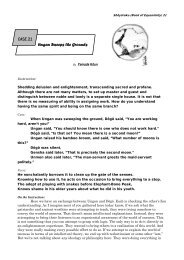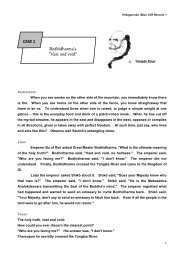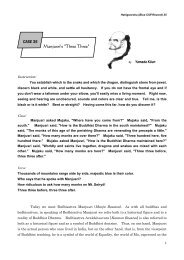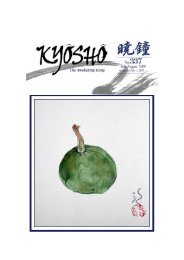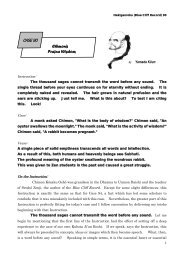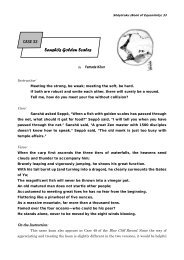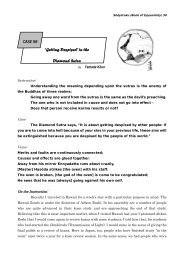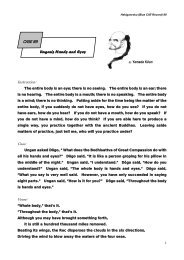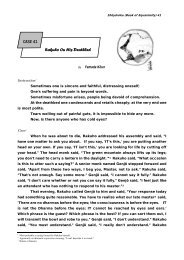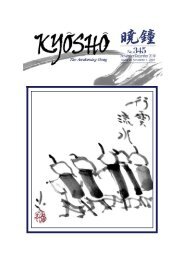A Non-Buddhist Questions the Buddha CASE 65
A Non-Buddhist Questions the Buddha CASE 65
A Non-Buddhist Questions the Buddha CASE 65
Create successful ePaper yourself
Turn your PDF publications into a flip-book with our unique Google optimized e-Paper software.
Hekiganroku (Blue Cliff Record) <strong>65</strong><br />
<strong>CASE</strong> <strong>65</strong><br />
A <strong>Non</strong>-<strong>Buddhist</strong><br />
<strong>Questions</strong> <strong>the</strong> <strong>Buddha</strong><br />
By<br />
Yamada Kôun<br />
Instruction:<br />
While having no form it has form. It is complete emptiness which<br />
stretches out in all directions. While having no mind it responds. It spreads out<br />
through <strong>the</strong> universe with no difficulty. In holding up one, he clarifies three. His<br />
eye immediately discerns pennyweights and ounces. Even if <strong>the</strong> blows of your<br />
stick fall like rain and your shout is like rolling thunder, you have yet to gain <strong>the</strong><br />
behavior of <strong>the</strong> truly outstanding person. But just tell me, what is <strong>the</strong> affair of<br />
<strong>the</strong> truly outstanding person? To test, I cite this case. Look!<br />
Case:<br />
A non-<strong>Buddhist</strong> asked <strong>the</strong> <strong>Buddha</strong>, “I do not ask about words, I do not ask<br />
about no-words.” The World-Honored One just sat still. The non-<strong>Buddhist</strong><br />
praised him, saying, “The World-Honored One in his great benevolence and great<br />
mercy has opened <strong>the</strong> clouds of my delusion and enabled me to enter <strong>the</strong> way.”<br />
After <strong>the</strong> non-<strong>Buddhist</strong> had left, Ananda asked <strong>Buddha</strong>, “What realization did <strong>the</strong><br />
non-<strong>Buddhist</strong> have that he said he had entered <strong>the</strong> way?” The <strong>Buddha</strong> replied,<br />
“He is just like a fine horse that runs at <strong>the</strong> shadow of <strong>the</strong> whip.”<br />
Verse:<br />
The wheel of activity has never yet turned.<br />
If it were to turn it would definitely run into two.<br />
A bright mirror is suddenly put on <strong>the</strong> stand.<br />
It instantaneously discerns <strong>the</strong> beautiful and <strong>the</strong> ugly.<br />
When <strong>the</strong> beautiful and ugly are discerned <strong>the</strong> clouds of delusion open.<br />
Where is <strong>the</strong>re any place for dust to appear on <strong>the</strong> gate of compassion?<br />
Therefore I think of <strong>the</strong> good horse discerning <strong>the</strong> shadow of <strong>the</strong> whip.<br />
After he has pursued <strong>the</strong> wind for a thousand li, I call him back.<br />
Upon my calling him and his turning back, I snap my fingers three times.<br />
On <strong>the</strong> Instruction:<br />
While having no form it has form. It is complete emptiness which stretches<br />
out in all directions. While having no mind it responds. It spreads out through <strong>the</strong><br />
1
Hekiganroku (Blue Cliff Record) <strong>65</strong><br />
universe with no difficulty. These first two lines form a pair speaking about our essential<br />
nature. You can also see <strong>the</strong>m as a reference to Mu. Our true self is just like this. To realize<br />
Mu is to realize this world to some degree. “While having no form it has form.” Recall <strong>the</strong><br />
words from <strong>the</strong> Hannyashingyô-Sutra: “Form is only emptiness, emptiness is only form.”<br />
While having no form at all, it is <strong>the</strong>re. And while it is <strong>the</strong>re, it is completely empty. The<br />
phenomenal world changes from moment to moment, and we don’t have to be experts on<br />
quantum <strong>the</strong>ory to know this. Your own body is not <strong>the</strong> same body that was <strong>the</strong>re yesterday;<br />
<strong>the</strong> content is changing constantly at an extremely fast rate. Some people understand this<br />
constant change and <strong>the</strong> lack of a lasting or fixed form to be that which is referred to in<br />
Buddhism as mujô or impermanence. They extrapolate and say this is emptiness [kû]. When<br />
you observe <strong>the</strong> quickly flowing waters of a river from a distance it would seem to be <strong>the</strong> same<br />
river which has existed from time immemorial. Look more closely and you realize that <strong>the</strong>re is<br />
never <strong>the</strong> same water in one place. There is nothing you can point to and say that this<br />
composes <strong>the</strong> river. Some people will use this example in talking of impermanence or<br />
emptiness in a <strong>Buddhist</strong> sense. They see emptiness [kû] as equal to impermanence. The<br />
famous <strong>Buddhist</strong> scholar, Inoue Shûten, for example, maintained this <strong>the</strong>ory.<br />
I discussed this once with Yasutani Roshi: “I can accept that <strong>the</strong> water in <strong>the</strong> river is<br />
constantly changing. But does <strong>the</strong> constantly changing water actually exist? ”If we have truly<br />
grasped emptiness, <strong>the</strong>re is no way we could point to <strong>the</strong> constantly changing phenomenal<br />
world and call it emptiness. For in actuality, even this does not exist. Yasutani Roshi replied,<br />
“This is a very big problem. Most people wouldn’t be able to understand up to that point.”<br />
Recall <strong>the</strong> lines from <strong>the</strong> Shôdôka [Song upon Realizing <strong>the</strong> Way]: “When we have truly<br />
realized <strong>the</strong>re is not one thing.” This doesn’t leave any room for talking about impermanence<br />
or emptiness. “When we realize actuality, <strong>the</strong>re is no distinction between mind and thing, and<br />
<strong>the</strong> path to hell instantly vanishes.” When we have truly realized <strong>the</strong> true nature of <strong>the</strong><br />
universe <strong>the</strong>re are nei<strong>the</strong>r persons nor things. There is nei<strong>the</strong>r subject nor object. There is<br />
nothing at all. There is “not a speck of cloud obstructing <strong>the</strong> eye.” How can we talk in terms<br />
of “constant flow”? Make no mistake. When we speak of emptiness (kû) we are talking about<br />
<strong>the</strong> universe itself which is totally empty. This is what we realize in <strong>the</strong> Zen experience.<br />
And yet, as <strong>the</strong> Instruction says, “while having no form it has form.” The phenomenal<br />
world extends out before us in its myriad forms, but is totally empty. “Form is emptiness,<br />
emptiness is form.” The “is” could be a source of confusion. We might be tempted to conclude<br />
that form and emptiness are two different things which somehow equal each o<strong>the</strong>r as A equals<br />
B. They are actually one and <strong>the</strong> same. But only direct experience will make this<br />
understandable.<br />
It fills space in <strong>the</strong> ten directions. When we say that it “fills space,” it might<br />
sound as if something is <strong>the</strong>re, but <strong>the</strong>re is actually nothing at all. Though it totally fills <strong>the</strong><br />
whole universe, we will never see it. “Is <strong>the</strong>re such a thing?” you may ask. Yes, <strong>the</strong>re is.<br />
Consider your own mind. Can you grasp your own mind? You absolutely cannot grasp your<br />
mind with your five senses. But does that mean that it doesn’t exist? Of course not. For<br />
<strong>the</strong>re you are listening to me and watching me right now. Sometimes you feel happy,<br />
2
Hekiganroku (Blue Cliff Record) <strong>65</strong><br />
sometimes sad. It is impossible to grasp with our five senses this heart-mind which sees,<br />
hears, feels happy or sad. And yet it exists.<br />
According to recent discoveries in quantum mechanics, elementary particles appear<br />
out of nowhere for billionths of a second and <strong>the</strong>n disappear again. It’s amazing in itself that<br />
physicists are able to calculate this. But where is <strong>the</strong> world from which <strong>the</strong>se elementary<br />
particles come?<br />
As <strong>the</strong> Instruction tells us, this substance fills <strong>the</strong> universe in all directions; it<br />
completely fills limitless space. This is essential nature, <strong>the</strong> true fact.<br />
While <strong>the</strong>re is no mind, it responds. Now we are talking solely in terms of <strong>the</strong><br />
objective world. The true reality is <strong>the</strong> true self, and <strong>the</strong> true self is <strong>the</strong> true reality. They<br />
are one and <strong>the</strong> same. “No mind” means <strong>the</strong> activity which completely lacks any type of trying<br />
or attempting. And in this way it responds perfectly. We hear without our trying to do so.<br />
When I call out, “Mr. Smith!”, he responds with “Yes!” If I am itching when I am sleeping,<br />
my hand stretches out involuntarily to scratch <strong>the</strong> itchy spot. These are all examples of “while<br />
<strong>the</strong>re is no mind it responds.” And although it responds, it is totally empty. When pressed to<br />
give a name to it, we call it “mind” or “heart” [kokoro]. The true substance of this no-mind or<br />
no-form “spreads out through <strong>the</strong> universe with no difficulty.” The universe contains myriad<br />
solar systems.<br />
The ancient Indians were constantly thinking in terms of <strong>the</strong> absolute or <strong>the</strong> infinite, a<br />
fact which we can surmise from looking at <strong>the</strong> sutras. For example, <strong>the</strong>re is <strong>the</strong> expression<br />
“three thousand great thousand worlds.” According to this <strong>the</strong>ory, a collection of one thousand<br />
solar systems is a “small thousand worlds.” And when a thousand of <strong>the</strong>se “small thousand<br />
worlds” are ga<strong>the</strong>red toge<strong>the</strong>r we have a “middle thousand worlds.” And when, now, a<br />
thousand “middle thousand worlds” are ga<strong>the</strong>red toge<strong>the</strong>r we have a “large thousand worlds.”<br />
Finally, when three thousand of <strong>the</strong>se “large thousand worlds” are ga<strong>the</strong>red toge<strong>the</strong>r we have<br />
“three thousand large thousand worlds.” But <strong>the</strong> actual universe is evidently far vaster even<br />
than that! At any rate, <strong>the</strong> Indians went to great pains to somehow explain <strong>the</strong> infinite<br />
universe. For example, <strong>the</strong>y considered <strong>the</strong> number of solar systems to be equal to <strong>the</strong> sands<br />
of <strong>the</strong> Ganges River, that is to say, limitless. Just when I was thinking this was impossible, I<br />
received information to <strong>the</strong> contrary!<br />
The o<strong>the</strong>r day I had a visit from a certain Chris Fang. This gentleman, an extremely<br />
fine fellow, was born in China but later became an American citizen. I first met him at a Zen<br />
sesshin in Hawaii several years ago. When I met him at that time he was working as a<br />
gardener’s helper, part-time work which he was forced to take to support himself. He is<br />
actually an astronomer by profession with a Ph.D. in that field. In Switzerland <strong>the</strong>re is an<br />
association for outstanding astronomers who receive research grants from <strong>the</strong> Swiss<br />
government. Every two years a research conference is held <strong>the</strong>re and Chris was on his way<br />
back from that meeting.<br />
I had difficulty understanding <strong>the</strong> explanation of astronomy which he expounded to me<br />
during his stay here. He used <strong>the</strong> expression “dark sea” in referring to <strong>the</strong> vast area of space<br />
in which our solar system finds itself and <strong>the</strong> unimaginably vast distances between our own<br />
3
Hekiganroku (Blue Cliff Record) <strong>65</strong><br />
solar system and <strong>the</strong> next one. And yet all of <strong>the</strong>se individual solar systems go on to comprise<br />
what we know as <strong>the</strong> Milky Way. And this Milky Way, in which our solar system is only a tiny<br />
speck, is revolving! There are limitless numbers of <strong>the</strong>se dark seas. Astronomers will take<br />
pictures of <strong>the</strong> sky on <strong>the</strong> last day of <strong>the</strong> year and use brightness as a means of measuring<br />
distance, which is invariably in terms of billions of light years. As you know, a light year is <strong>the</strong><br />
distance a beam of light travels in a year. Thus, to speak in terms of billions of light years<br />
truly defies <strong>the</strong> imagination. This also means that <strong>the</strong> light we see from <strong>the</strong> stars now was<br />
actually emitted billions of years ago.<br />
I asked him what was happening at <strong>the</strong> end of <strong>the</strong> universe but even he didn’t know <strong>the</strong><br />
answer to that. At any rate, <strong>the</strong> universe is truly limitless and beyond our wildest imaginings.<br />
The people of ancient India did not prove this with <strong>the</strong>ir ma<strong>the</strong>matics, but <strong>the</strong>y did have an<br />
intuitive or intellectual grasp of this vastness, which is to <strong>the</strong>ir credit.<br />
The substance which totally fills this incredibly vast space is no o<strong>the</strong>r than <strong>the</strong><br />
substance of our own essential nature. This may be hard for you to believe upon just hearing<br />
it. I can hear some of you saying, “My essential nature filling <strong>the</strong> universe? Why, I’m just an<br />
ordinary office worker!” But it’s really true. I wish for each of you to experience this yourself.<br />
In holding up one, he clarifies three. His eye immediately discerns<br />
pennyweights and ounces. Here is a person like <strong>the</strong> non-<strong>Buddhist</strong> in <strong>the</strong> main case who<br />
only needs to hear about one to understand three. It is an expression of extremely quick<br />
perception. He doesn’t even need a scale to immediately guess <strong>the</strong> weight of even very small<br />
objects. This, too, is a metaphor for an extremely quick-witted person.<br />
Even if <strong>the</strong> blows of your stick fall like rain and your shout is like rolling<br />
thunder, you have yet to gain <strong>the</strong> behavior of <strong>the</strong> truly outstanding person. The<br />
first two lines speak about <strong>the</strong> extremely vigorous activity of <strong>the</strong> true Zen person as shown in<br />
Tokusan’s use of <strong>the</strong> stick or Rinzai’s cries of Katsu! No matter what <strong>the</strong> student asked,<br />
Tokusan would immediately hit him with his stick. Blows falling like rain must be numerous<br />
indeed. Shouts like rolling thunder, being Rinzai’s specialty, must be a reference to that<br />
illustrious master. But, as <strong>the</strong> Instruction tells us, even a Zen person with such intensity has<br />
yet to reach <strong>the</strong> state of <strong>the</strong> truly outstanding Zen person. Recall <strong>the</strong> first lines of <strong>the</strong><br />
Instruction: “While having no form, it has form. It is complete emptiness which stretches out<br />
in all directions. While having no mind it responds. It spreads out through <strong>the</strong> universe with<br />
no difficulty.“<br />
“With no difficulty” is important. In recent days, <strong>the</strong> labor unions and teachers’ union<br />
often demonstrate for changes. But here <strong>the</strong>re is no strife whatsoever. A “truly outstanding<br />
person” is one who has made this world his or her own. This is clearly a reference to<br />
Shakyamuni <strong>Buddha</strong>.<br />
The standard for all Zen persons, when we get down right down to it, is Shakyamuni<br />
<strong>Buddha</strong> himself. Comparing <strong>the</strong> many masters of <strong>the</strong> past with Shakyamuni is enough to see<br />
just what level <strong>the</strong>se people had arrived at in <strong>the</strong>ir understanding. The sutras and Zen<br />
records contain no mention of <strong>the</strong> <strong>Buddha</strong> Shakyamuni ever striking with a stick or shouting<br />
“Katsu!” In today’s koan, for example, <strong>the</strong> <strong>Buddha</strong> sat perfectly still in response to <strong>the</strong><br />
4
Hekiganroku (Blue Cliff Record) <strong>65</strong><br />
non-<strong>Buddhist</strong>’s question. Shakyamuni is forever <strong>the</strong> very model of gentleness when he<br />
appears in <strong>the</strong> koans. Consider, for example, Case 1 of <strong>the</strong> Book of Serenity: “The<br />
World-Honored One Ascends <strong>the</strong> Rostrum”:<br />
One day <strong>the</strong> World Honored One ascended <strong>the</strong> rostrum. Manjusri struck <strong>the</strong><br />
gavel and said, “See clearly <strong>the</strong> Dharma-king’s Dharma. The Dharma-king’s<br />
Dharma is like this.” The World Honored One <strong>the</strong>n descended from <strong>the</strong><br />
rostrum.<br />
Here,too, he reveals <strong>the</strong> Dharma in his sitting still. Shouts of “Katsu!” and blows from <strong>the</strong><br />
stick are still all too green. They have yet to attain <strong>the</strong> behavior of <strong>the</strong> truly outstanding<br />
person.<br />
But just tell me, what is <strong>the</strong> affair of <strong>the</strong> truly outstanding person? To test,<br />
I cite this case. Look! But what is <strong>the</strong> behavior of <strong>the</strong> truly outstanding Zen person. I<br />
will show an example to you now, so look carefully.<br />
On <strong>the</strong> Case:<br />
A non-<strong>Buddhist</strong> asked <strong>the</strong> <strong>Buddha</strong>, “I do not ask about words, I do not ask<br />
about no-words.” The World-Honored One just sat still. This koan also appears as<br />
Case 31 of <strong>the</strong> Gateless Gate. The word used in <strong>the</strong> original text for non-<strong>Buddhist</strong>, Gedô,<br />
actually refers to any of <strong>the</strong> approximately 96 non-<strong>Buddhist</strong> schools of Indian philosophy<br />
existing at that time, all of which were characterized by extremely profound thought, masterful<br />
analysis and penetrating syn<strong>the</strong>sis. For <strong>the</strong> most part, however, <strong>the</strong>y still concerned<br />
<strong>the</strong>mselves with <strong>the</strong> phenomenal. The tradition of Indian wisdom evidently had its start in<br />
<strong>the</strong> Himalayas and <strong>the</strong>n spread out to <strong>the</strong> rest of India. Although this is just supposition on<br />
my part, I sometimes wonder if this original tradition didn’t eventually spread to Greece and<br />
Rome and become <strong>the</strong> foundation for Western thought, especially <strong>the</strong> German schools of<br />
philosophy. I also sometimes wonder if <strong>the</strong> o<strong>the</strong>r branch didn’t <strong>the</strong>n spread out to <strong>the</strong> East.<br />
That would mean that <strong>the</strong> encounter which takes place in today’s case is between a<br />
representative of <strong>the</strong> philosophical tradition which eventually spread to <strong>the</strong> West and <strong>the</strong><br />
<strong>Buddha</strong>, whom we can see as representing <strong>the</strong> Eastern tradition of direct, intuitive wisdom.<br />
An outstanding intellect is certainly a great asset. Many are those who believe <strong>the</strong>y<br />
can understand Zen with <strong>the</strong> intellect. But <strong>the</strong> ideal Zen experience is seeing with <strong>the</strong> same<br />
clarity and directness that a mirror has which reflects everything which comes before it.<br />
It often occurs, in <strong>the</strong> process of working on koans, that people will discover a certain logic<br />
running through <strong>the</strong>m. Instead of directly perceiving <strong>the</strong> koan as a mirror reflects that which<br />
comes before it, <strong>the</strong>y will come up with an answer in <strong>the</strong>ir heads. To be quite frank, this is not<br />
<strong>the</strong> real thing. Never<strong>the</strong>less, I believe that continuing to work on koans while sitting<br />
steadfastly will deepen <strong>the</strong> original experience to <strong>the</strong> point where it can truly reflect like a<br />
mirror.<br />
The non-<strong>Buddhist</strong> came to Shakyamuni <strong>Buddha</strong> and said, “I do not ask about words, I<br />
do not ask about no-words.” This is a very crafty question. If <strong>the</strong> <strong>Buddha</strong> uses words to<br />
answer, <strong>the</strong> non-<strong>Buddhist</strong> will say, “Aren’t those words? That is not what I asked about. I do<br />
5
Hekiganroku (Blue Cliff Record) <strong>65</strong><br />
not ask about words and I do not ask about no-words.” He presses Shakyamuni into a corner.<br />
We need not emphasize words or no-words. The important matter is being or non-being. The<br />
non-<strong>Buddhist</strong> wants to know about that which transcends <strong>the</strong>m both. He asks, “I do not ask<br />
about form and I do not ask about emptiness. I do not ask about <strong>the</strong> phenomenal and I do not<br />
ask about <strong>the</strong> essential.” But how does <strong>the</strong> <strong>Buddha</strong> respond?<br />
“The World-Honored One just sat still.” You may think that this is no-words, but as<br />
Engo says in his critical comment to this line, “His voice is like thunder.” In his sitting still,<br />
<strong>the</strong> <strong>Buddha</strong> emits a voice like thunder. The non-<strong>Buddhist</strong> was able to realize this on <strong>the</strong> spot.<br />
“Ha-ha! Now I understand!” He didn’t understand it with his head. Such a realization<br />
would not have been possible on a purely intellectual level. It was true experience which led<br />
him to exclaim as he did. It appears that this man had been practicing with all his might<br />
before he met <strong>the</strong> <strong>Buddha</strong> and that his practice had ripened to <strong>the</strong> point where <strong>the</strong> response of<br />
<strong>the</strong> <strong>Buddha</strong> was enough to touch off true experience.<br />
The non-<strong>Buddhist</strong> praised him, saying, “The World-Honored One in his<br />
great benevolence and great mercy has opened <strong>the</strong> clouds of my delusion and<br />
enabled me to enter <strong>the</strong> way.” It is quite possible that this person later became a<br />
<strong>Buddhist</strong> disciple. Some books mention similar such encounters. If we look at <strong>the</strong><br />
Transmission of Light [Denkôroku], for example, we find several cases which speak of how a<br />
non-<strong>Buddhist</strong> philosopher of great intellectual brilliance has a dialogue with a <strong>Buddhist</strong><br />
patriarch. This person may have been one of <strong>the</strong>m.<br />
After <strong>the</strong> non-<strong>Buddhist</strong> had left, Ananda asked <strong>Buddha</strong>, “What realization<br />
did <strong>the</strong> non-<strong>Buddhist</strong> have that he said he had entered <strong>the</strong> way?” The <strong>Buddha</strong><br />
replied, “He is just like a fine horse that runs at <strong>the</strong> shadow of <strong>the</strong> whip.”<br />
Ananda was third in <strong>the</strong> line of patriarchs descending from <strong>the</strong> <strong>Buddha</strong>, in o<strong>the</strong>r words, <strong>the</strong><br />
second patriarch of Indian Buddhism. One of <strong>the</strong> original disciples of <strong>the</strong> <strong>Buddha</strong>, he received<br />
<strong>the</strong> name Tamon Dai-Ichi [“First Among Hearers”] while acting as attendant to Shakyamuni<br />
for twenty years. Following <strong>the</strong> death of <strong>the</strong> <strong>Buddha</strong>, <strong>the</strong> Dharma was transmitted to<br />
Mahakasyapa. At <strong>the</strong> time of this koan, Ananda was still acting as attendant to <strong>the</strong> <strong>Buddha</strong><br />
and had yet to attain realization. He stood on <strong>the</strong> side and watched this exchange without<br />
understanding what was going on. After <strong>the</strong> non-<strong>Buddhist</strong> had left, Ananda asked <strong>the</strong><br />
<strong>Buddha</strong>, “That philosopher just thanked you profusely and said that he had attained<br />
enlightenment. What did he realize?”<br />
The <strong>Buddha</strong> answered, “He is just like a fine horse that runs at <strong>the</strong> shadow of <strong>the</strong><br />
whip.” Notice that <strong>the</strong> <strong>Buddha</strong> makes no attempt to explain <strong>the</strong> content of <strong>the</strong> non-<strong>Buddhist</strong>’s<br />
experience. Instead, he refers to <strong>the</strong> extremely penetrating, wonderful Zen activity of <strong>the</strong><br />
non-<strong>Buddhist</strong>.<br />
It is said that <strong>the</strong>re are four types of horses. The finest horse is said to start running<br />
when <strong>the</strong> whip barely touches <strong>the</strong> hairs on its back. This horse in <strong>the</strong> koan is even better than<br />
that; he needs only to see <strong>the</strong> shadow of <strong>the</strong> whip to be off and running.<br />
The second grade of horse runs when he feels <strong>the</strong> sting of <strong>the</strong> whip in his skin, and <strong>the</strong><br />
third type when he feels <strong>the</strong> sting of <strong>the</strong> whip in his flesh. The fourth and worst type of horse<br />
6
Hekiganroku (Blue Cliff Record) <strong>65</strong><br />
will only start running when he feels <strong>the</strong> sting of <strong>the</strong> whip in his marrow! How is it for all of<br />
you? Has it penetrated to <strong>the</strong> marrow yet? (General laughter) But <strong>the</strong>re are horses that will<br />
not even run when <strong>the</strong> whip penetrates to <strong>the</strong> marrow! (More laughter) If we add this<br />
classification and <strong>the</strong> type of horse which runs at <strong>the</strong> shadow of <strong>the</strong> whip, we have a total of six<br />
types.<br />
It is said traditionally that, for <strong>the</strong> practice of Zen, it is not <strong>the</strong> least bit necessary to be<br />
intellectually brilliant or to be a very learned person or good logician. But quickness of<br />
perception is a definite asset. It has also been said that a sharp mind is important for zazen,<br />
but I do not necessarily agree. The story of Ikkyû Oshô when he was a boy is often quoted as<br />
an example of this. But when we get down to it, this is no more than being quick-witted.<br />
True appropriateness of response emerges from <strong>the</strong> wisdom of satori. But, as I said, even<br />
before attaining enlightenment, a certain amount of quickness in perception is important. If<br />
we truly make our finest alert efforts we will realize. Such an activity of <strong>the</strong> heart-mind is<br />
necessary, I feel. Although keen intelligence is not indispensable for Zen, it is necessary to be<br />
sharp and alert in our practice. Dullness is certainly no asset. And this is not limited to zazen.<br />
In everyday life, too, we don’t know what’s going to happen next. We have to be ready for<br />
sudden changes.<br />
On <strong>the</strong> Verse:<br />
The wheel of activity has never yet turned. If it were to turn it would<br />
definitely run into two. “The wheel of activity” means those activities which appear on <strong>the</strong><br />
surface. The wheel of activity which has never turned must be a reference to <strong>the</strong> essential self.<br />
Having walked <strong>the</strong> entire day, we have not taken a step. As soon as <strong>the</strong> activity appears in<br />
<strong>the</strong> phenomenal world, it must become two; in o<strong>the</strong>r words, being and non-being or form and<br />
emptiness. What is that which transcends this? Look at <strong>the</strong> next lines of <strong>the</strong> verse.<br />
A bright mirror is suddenly put on <strong>the</strong> stand. It instantaneously discerns<br />
<strong>the</strong> beautiful and <strong>the</strong> ugly. This is referring to how <strong>the</strong> <strong>Buddha</strong> just sat still. A perfectly<br />
clear mirror reflects both <strong>the</strong> ugly and <strong>the</strong> beautiful. When <strong>the</strong> non-<strong>Buddhist</strong> questions <strong>the</strong><br />
<strong>Buddha</strong>, his uprightness and shortcomings, his depth or shallowness are perfectly reflected.<br />
When <strong>the</strong> beautiful and ugly are discerned <strong>the</strong> clouds of delusion open.<br />
Where is <strong>the</strong>re any place for dust to appear on <strong>the</strong> gate of compassion? Both<br />
beauty and ugliness are clearly reflected and <strong>the</strong> delusions of <strong>the</strong> non-<strong>Buddhist</strong> are swept away.<br />
But what does this actually mean? The non-<strong>Buddhist</strong> has become one with <strong>the</strong> mirror. He<br />
has become “<strong>the</strong> non-<strong>Buddhist</strong> in <strong>the</strong> mirror.” The two mirrors reflect each o<strong>the</strong>r perfectly.<br />
That which is reflected here 1 is reflected here 2 and vice-versa. He realized instantaneously<br />
that it was one and <strong>the</strong> same. Thus, although he was brought to enlightenment by<br />
Shakyamuni <strong>Buddha</strong>, he was also completely one with <strong>the</strong> world of <strong>the</strong> <strong>Buddha</strong>. It was at that<br />
moment that <strong>the</strong> clouds of delusion were finally swept away. There was not <strong>the</strong> slightest<br />
speck of dust clinging to <strong>the</strong> <strong>Buddha</strong>’s mirror of great compassion.<br />
1 Roshi holds up his left hand.<br />
2<br />
He holds up his right hand.<br />
7
Hekiganroku (Blue Cliff Record) <strong>65</strong><br />
Therefore I think of <strong>the</strong> good horse discerning <strong>the</strong> shadow of <strong>the</strong> whip.<br />
After he has pursued <strong>the</strong> wind for a thousand li, I call him back. As <strong>the</strong> verse says,<br />
it is for this reason that we are drawn to compare <strong>the</strong> quick response of <strong>the</strong> non-<strong>Buddhist</strong> to <strong>the</strong><br />
horse which starts to run at <strong>the</strong> shadow of <strong>the</strong> whip. “The One That Chases <strong>the</strong> Wind for a<br />
Thousand Li” was <strong>the</strong> name of a horse belonging to <strong>the</strong> Ch’in dynasty. The Emperor of Ch’in<br />
had seven outstanding steeds and <strong>the</strong> best among <strong>the</strong>m could reportedly run a thousand li<br />
[Chinese miles] in a single day. This is once again a reference to <strong>the</strong> non-<strong>Buddhist</strong>. If he is<br />
let loose he will run off in ano<strong>the</strong>r direction, but <strong>the</strong> <strong>Buddha</strong> called him back with his action.<br />
In o<strong>the</strong>r words, when <strong>the</strong> non-<strong>Buddhist</strong> saw <strong>the</strong> <strong>Buddha</strong> sitting still, he suddenly realized and<br />
came back.<br />
Upon my calling him and his turning back, I snap my fingers three times.<br />
Here is Setchô having his say on <strong>the</strong> matter. “You say that he came back when you called, but<br />
wait! A horse which comes back when called is not worth very much!” The non-<strong>Buddhist</strong><br />
came to enlightenment upon seeing <strong>the</strong> <strong>Buddha</strong> and “came back.” But a real horse, says<br />
Setchô, should run free with <strong>the</strong> wind. What was wrong with him while he was still a<br />
non-<strong>Buddhist</strong>? Is <strong>the</strong>re really any difference between <strong>the</strong> non-<strong>Buddhist</strong> before his realization<br />
and afterward?” From <strong>the</strong> essential standpoint this is quite true. “Upon my calling him and<br />
his turning back, I snap my fingers three times.” A horse which turns back upon being called<br />
is not of much use. The snapping of <strong>the</strong> fingers is a sign of displeasure. But this snapping of<br />
<strong>the</strong> fingers actually has two meanings. One meaning is driving it away in displeasure. The<br />
o<strong>the</strong>r meaning is a warning, bringing <strong>the</strong> matter to everyone’s attention. It was traditional<br />
custom to snap your fingers upon entering a room. It was also common practice in old times to<br />
snap one’s fingers upon entering <strong>the</strong> toilet to drive away impurity. The snapping of <strong>the</strong> fingers<br />
here in <strong>the</strong> verse is of <strong>the</strong> first type, in o<strong>the</strong>r words, a sign of displeasure toward <strong>the</strong><br />
good-for-nothing horse which immediately turns back when it is called. This is viewing things<br />
from <strong>the</strong> essential standpoint. Setchô views things from a ra<strong>the</strong>r lofty vantage point.<br />
(translated by Paul Shepherd)<br />
8


